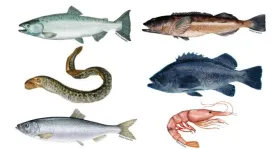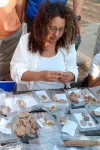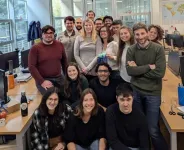(Press-News.org) The tiny particles that shed from clothing, packaging and other plastic products are winding up in the fish that people eat, according to a new study from Portland State researchers, highlighting a need for technologies and strategies to reduce microfiber pollution entering the environment.
Building on previous research exploring the prevalence of microplastics in bivalves like Pacific oysters and razor clams, researchers in PSU’s Applied Coastal Ecology Lab — led by Elise Granek, professor of environmental science and management — turned their focus to commonly eaten finfish and crustaceans.
Summer Traylor, who graduated in 2022 with a master’s in environmental management, led the project with assistance from undergraduate environmental science student Marilyn Duncan, who graduated in 2024. The team set out to fill in gaps about microplastic contamination in Oregon finfish and shellfish and better understand variations across trophic levels, which classify a fish’s position in the food chain, and in pathways to consumers. Traylor’s research helped her land a job working for the National Oceanic and Atmospheric Administration (NOAA) after graduating from PSU, and Duncan has plans to continue microplastics research in graduate school.
The team quantified anthropogenic particles, materials produced or modified by humans, that they found in the edible tissue of six species that are economically or culturally important in Oregon: black rockfish, lingcod, Chinook salmon, Pacific herring, Pacific lamprey, and pink shrimp.
They compared particle concentrations across trophic levels and whether their position in the food web affected what and how much was contaminating their edible tissue as well as whether there were differences in samples acquired directly from research fishing vessels versus those from supermarkets and seafood vendors. Susanne Brander, an ecotoxicologist and associate professor in Oregon State University’s College of Agricultural Sciences, helped analyze and validate a subsample of suspected plastics in her lab.
The study, published in the journal Frontiers in Toxicology, found 1,806 suspected particles across 180 of 182 individual samples. Fibers were the most abundant, followed by fragments and films.
Among the species sampled, pink shrimp, which filter-feed right below the surface of the water, had the highest concentrations of particles in their edible tissues. Chinook salmon had the lowest concentrations, followed by black rockfish and lingcod.
“We found that the smaller organisms that we sampled seem to be ingesting more anthropogenic, non-nutritious particles,” Granek said. “Shrimp and small fish, like herring, are eating smaller food items like zooplankton. Other studies have found high concentrations of plastics in the area in which zooplankton accumulate and these anthropogenic particles may resemble zooplankton and thus be taken up for animals that feed on zooplankton.”
Though the group expected that the processing from catch to consumer would introduce additional contaminants from plastic packaging meant to preserve seafood, that wasn’t universally true across the species. The researchers rinsed off the fish fillets and shrimp, replicating what most people do at home before preparing them, suggesting that in some cases, additional contamination that may land on the surface during processing can be removed with rinsing.
The study results, however, provide evidence of the widespread presence of particles in the edible tissues of Oregon’s marine and freshwater species.
“It’s very concerning that microfibers appear to move from the gut into other tissues such as muscle,” Brander said. “This has wide implications for other organisms, potentially including humans too.”
The researchers say the findings signal the need for both further studies to understand the mechanisms by which particles translocate into muscle tissue, which humans eat, as well as policy interventions to regulate anthropogenic particles.
“This project established critical baseline data for West Coast fisheries stakeholders and highlighted how much we still do not know about these pervasive microplastic pollutants,” said Traylor, who now serves as a NOAA Corps Officer, helping collect baseline microplastic data in the Gulf of Mexico to further expand public knowledge and understanding.
The authors are not advocating for people to stay away from seafood because, as Granek likes to remind people, microplastics are everywhere: in bottled water, beer, honey, beef, chicken, veggie burgers and tofu.
“If we are disposing of and utilizing products that release microplastics, those microplastics make their way into the environment, and are taken up by things we eat,” she said. “What we put out into the environment ends up back on our plates.”
That’s why Granek’s lab group is beginning to focus more on solutions.
“We're continuing to do work to understand the effects of anthropogenic particles on animals, but we're also moving into experimental work to test what are effective solutions to reduce microplastics entering marine ecosystems,” she said.
She’s leading a $1.9 million NOAA-funded project that is developing and testing washing machine, dishwasher and clothes dryer filters that can serve as cost-effective filtration solutions. In another project funded by Oregon Sea Grant, six catch basin filters will be installed in stormwater drains in two coastal towns to determine their efficacy in trapping microplastics from road runoff before entering waterways. Brander’s lab is collaborating on both projects as well.
END
Microplastics widespread in seafood people eat
2025-01-06
ELSE PRESS RELEASES FROM THIS DATE:
Lead pollution likely caused widespread IQ declines in ancient Rome, new study finds
2025-01-06
Lead exposure is responsible for a range of human health impacts, with even relatively low levels impacting the cognitive development of children. DRI scientists have previously used atmospheric pollution records preserved in Arctic ice cores to identify periods of lead pollution throughout the Roman Empire, and now new research expands on this finding to identify how this pollution may have affected the European population.
The study, published Jan. 6th in Proceedings of the National Academy of Sciences (PNAS), ...
Researchers reveal ancient dietary habits and early human use of plant foods
2025-01-06
A new archaeological study, conducted along the Jordan River banks south of northern Israel’s Hula Valley, offers a fresh perspective on the dietary habits of early humans, challenging conventional wisdom about prehistoric diets. The research reveals that ancient hunter-gatherers relied heavily on plant foods, particularly starchy plants, as a major energy source. The findings suggest that, contrary to popular belief, the diet of early hominids was not solely focused on animal protein, but rather, featured a diverse range of plant-based foods, including acorns, cereals, ...
NRG Oncology adds new theranostics subcommittee to organization, new leadership members for CCDR and early phase trial oversight committees
2025-01-06
NRG Oncology (NRG), a National Cancer Institute (NCI) National Clinical Trials Network (NCTN) group focused on improving outcomes for adults with cancer through multi-center clinical research, recently announced the creation of a new Theranostics Subcommittee, as well as two leadership role updates within the organization’s current committees.
NRG established the Theranostics Subcommittee under the Imaging Committee and Radiation Oncology Committee umbrellas within the organization as theranostics is a medical field that combines diagnostic imaging and therapeutic interventions. The Theranostics Subcommittee will be focused on the following goals: building a more robust theranostics ...
New NEJM Perspective article highlights urgent need for widespread adoption of Fracture Liaison Services (FLS) to combat rising burden of osteoporosis-related fractures
2025-01-06
A new Perspective article published in the New England Journal of Medicine emphasizes the critical role of Fracture Liaison Services (FLS) in addressing the growing global burden of osteoporosis-related fractures, particularly hip fractures.
The World Health Organization has identified osteoporosis as a major global health issue because it poses significant risks of disability and premature death. Osteoporosis-related fractures are a leading cause of disability and long-term care needs for older adults, with hip fractures being particularly devastating. The Perspective reports that within the first 12 months following a hip fracture, ...
Hornwort genomes provide clues on how plants conquered the land
2025-01-06
Over 450 million years ago, plants began the epic transition from water to dry land. Among the first pioneers were the ancestors of humble hornworts, a group of small, unassuming plants that have persisted to this day. New research reveals insights into the genetic blueprints of hornworts, uncovering fascinating details about plant evolution and the early days of life on land.
“We began by decoding the genomes of ten hornwort species, representing all known families within this unique plant group,” said Peter Schafran, a postdoctoral scientist at the Boyce Thompson Institute ...
New mechanism discovered that triggers immune response in cells with damaged DNA
2025-01-06
Irvine, Calif., Jan. 6, 2025 — A research team from the University of California, Irvine has revealed a previously unknown mechanism that triggers an inflammatory immune response in cells when their DNA is damaged. This discovery deepens the understanding of a new type of cell signaling that may lead to more effective treatments for cancer.
The study, published online today in the journal Nature Structural & Molecular Biology, found that UV irradiation or certain chemotherapeutic drugs activate a specific response when cells are too damaged to be repaired correctly, preventing them from becoming cancerous.
“This discovery could have significant ...
Model proposed for treating loneliness in borderline personality disorder
2025-01-06
January 6, 2025 — Loneliness is a key driver in the maintenance of borderline personality disorder (BPD), Harvard researchers argue. Thus, many patients cite increased social connection as a primary treatment goal. In the Harvard Review of Psychiatry, part of the Lippincott portfolio from Wolters Kluwer, Lois W. Choi-Kain, MD, MEd, DFAPA, of Harvard’s McLean Hospital, and colleagues call for BPD treatment to extend beyond exclusive therapeutic relationships to help patients build durable connections with others in the community.
"Any support in building small connections can provide some relief from loneliness and work against cycles of dependency, ...
Marco Demaria named editor-in-chief of Aging (Aging-US)
2025-01-06
BUFFALO, NY- January 6, 2025 – We are pleased to announce that Dr. Marco Demaria, a leading expert in aging and cellular senescence, has joined Aging (Aging-US) as Editor-in-Chief, effective January 1, 2025. Dr. Demaria will work alongside an esteemed Editorial Board.
Dr. Demaria has an impressive background in aging research. He earned his PhD in Molecular Medicine from the University of Torino, Italy. In 2010, he joined the laboratory of Aging Founding Editor, the late Dr. Judith Campisi, at the Buck Institute for Research on Aging. There ...
A healthy diet is key to a healthy gut microbiome
2025-01-06
A varied diet rich in vegetables is known to be healthy for one’s well-being. Excessive consumption of meat, especially red meat, can lead to chronic and cardiovascular diseases. That is also because what we eat shapes the gut microbiome. At the same time, excluding certain foods, such as dairy or animal products, is not necessarily a general solution to achieve microbial balance. But can we find out which food products determine differences in the gut microbiome? Starting from this question, a group of researchers analyzed biological samples from 21,561 individuals (vegans, vegetarians and omnivores) living in the ...
New study links millions of diabetes and heart disease cases globally to sugary drinks
2025-01-06
A new study from researchers at the Gerald J. and Dorothy R. Friedman School of Nutrition Science and Policy at Tufts University, which published in Nature Medicine on January 6, estimates that 2.2 million new cases of type 2 diabetes and 1.2 million new cases of cardiovascular disease occur each year globally due to consumption of sugar-sweetened beverages.
In developing countries, the case count is particularly sobering. In Sub-Saharan Africa, the study found that sugar-sweetened beverages contributed to more than 21% of all new diabetes cases. In Latin America and the Caribbean, they contributed to nearly 24% of new diabetes cases and more than 11% of new cases of cardiovascular ...








